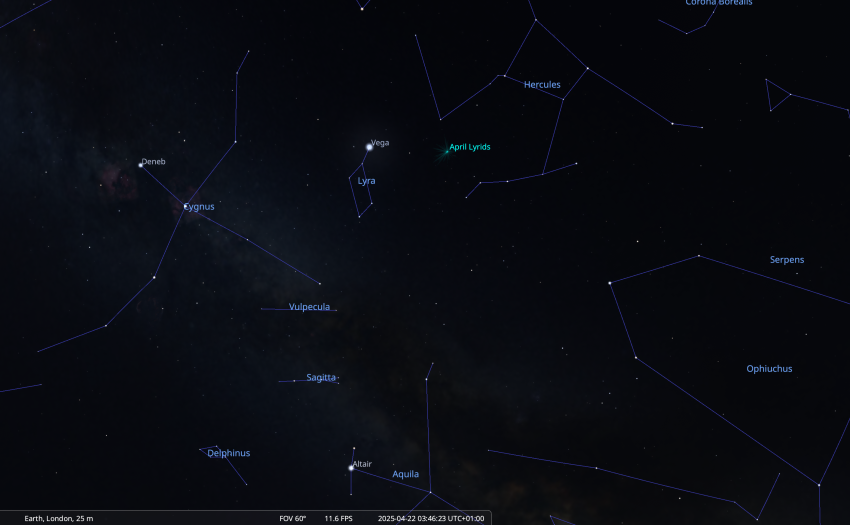Stargazers will have a chance to enjoy one of the oldest known meteor showers over the next week, as the Lyrids bring their fast and bright 'shooting stars' to the night sky.
Although not as plentiful as the Perseids in August or Geminids in December, the Lyrid meteor shower could still make for an entertaining celestial show between 17 and 26 April 2025.
The Lyrids don't tend to leave long and persistent dust trains as they streak through the Earth's atmosphere, but they are capable of producing the odd 'fireball', or bright flash in the sky.
They were first recorded 2,700 years ago by the Chinese in the 7th century BCE.
Under perfect conditions, skywatchers can expect to see 10 to 15 meteors per hour when the Lyrids peak on the night of 21 April into the early hours of 22 April, as long as skies are clear.
Although there will be a waning crescent moon, it won't rise until at least dawn in the Northern Hemisphere, so this shouldn't impact the view. The radiant of the Lyrids is also high for those observing from the UK.
Dr Robert Massey, Deputy Executive Director of the Royal Astronomical Society, shared some tips on how best to see the meteor shower.
"With the Lyrids, you'll be looking for a little flurry of short-lived streaks of light – what you might popularly call 'shooting stars'," he said in a video explainer.
"With this particular shower you could expect to see maybe 10 to 15 an hour at the peak, so it's not massively prolific… but if you've got a clear sky it's still very much worth it."
Meteors are small pieces of interplanetary debris – typically from comets – which burn up in the Earth's atmosphere after coming in at high speeds.
Friction with the upper atmosphere quickly heats up the incoming debris, the air around them glows brightly, and the particles are rapidly destroyed. The resulting streak of light is what we see from the ground as a meteor, or 'shooting star'.
"The good thing about a meteor shower – and the Lyrids are no exception – is that you don't need any special equipment," Dr Massey explained.
"The best equipment is just your eyes, looking up at the sky. Now in this particularly case, the radiant – the point of the sky they appear to come from – is in the constellation of Lyra, near the bright star Vega, part of the Summer Triangle.
"So if you're looking in the small hours of the morning – which is the best time to look – then if you've got a clear sky just look up. The radiant will be slightly over towards the east, but it's not absolutely critical which direction you're looking."
The Lyrids come from the tail of Comet Thatcher, which last came close to the Sun in 1861. This comet takes more than 400 years to complete its orbit, so will next be close to the Earth in the 23rd century.
Like all comets, Thatcher leaves a stream of debris in its wake. When the Earth runs into that material, some of it burns up in our atmosphere – meaning we see more meteors than usual.
If you manage to get any pictures or videos of the Lyrid meteor shower then we'd love to see them. You can find us on Instagram, Bluesky, LinkedIn, Facebook and YouTube.
ENDS
Media contacts
Sam Tonkin
Royal Astronomical Society
Mob: +44 (0)7802 877 700
Dr Robert Massey
Royal Astronomical Society
Mob: +44 (0)7802 877 699
Video, images and captions
Lyrid meteor shower video explainer
Caption: Dr Robert Massey, Deputy Executive Director of the Royal Astronomical Society, explains how to observe the Lyrid meteor shower from 17 to 26 April 2025.
Credit: Royal Astronomical Society
Caption: A view of the area of the night sky where the Lyrids appear to originate, close to the constellation Lyra (the harp), and specifically the star Vega, which is the brightest star in this constellation.
Credit: Stellarium
Notes for editors
About the Royal Astronomical Society
The Royal Astronomical Society (RAS), founded in 1820, encourages and promotes the study of astronomy, solar-system science, geophysics and closely related branches of science.
The RAS organises scientific meetings, publishes international research and review journals, recognises outstanding achievements by the award of medals and prizes, maintains an extensive library, supports education through grants and outreach activities and represents UK astronomy nationally and internationally. Its more than 4,000 members (Fellows), a third based overseas, include scientific researchers in universities, observatories and laboratories as well as historians of astronomy and others.
The RAS accepts papers for its journals based on the principle of peer review, in which fellow experts on the editorial boards accept the paper as worth considering. The Society issues press releases based on a similar principle, but the organisations and scientists concerned have overall responsibility for their content.
Keep up with the RAS on Instagram, Bluesky, LinkedIn, Facebook and YouTube.
Download the RAS Supermassive podcast


